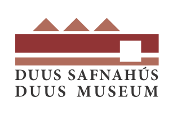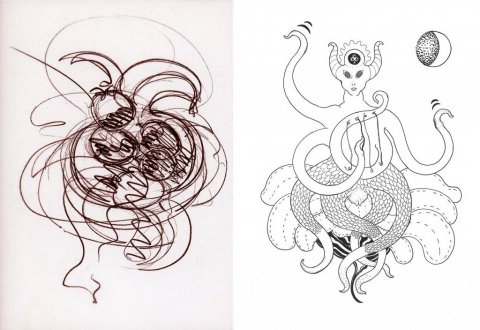Sporbaugur/Ellipse
Gabríela Friðriksdóttir and Björn Roth will open Sporbaugur/Ellipse in Reykjanes Art Museum on saturday the 28th of May. The exhibition will be on display until the 13th of November 2022.
Ellipse
Colouring books for children are a strange thing. What are they for? They do not develop the children’s creative thinking: they are told not to colour outside the lines and their only avenue of expression in thought the choice of colours. Perhaps the pedagogical value is only that: To teach the child to follow the rules and accept the fact that they will only control the least important aspects of their lives. This colouring book, by Gabríela Friðriksdóttir and Björn Roth, seems to follow this formula. This book, however, is part of an art exhibition in an art museum and the original drawings are framed on the walls, presented to visitors in much the way children run to mother to show her how neatly they coloured in the page in their book. Everything here is like a fairy tale and our imagination is set free. Installations and video works draw us deeper into this mysterious world where anything can happen and anything can become art.
How can it be that fully-grown artists have such interest in the world and experience of children? Pablo Picasso used to say – as recalled by his granddaughter, Marina – that he had spent his whole life learning how to paint like a child. We can assume that he didn’t mean to say that his paintings were childish, but that there was something in the child’s experience and approach to the world that he had lost and had to relearn. This almost impossible, as we can see by reading the first chapters of most any autobiography – they tend to be full of unnecessarily detailed, yet incoherent, descriptions and after-the-fact observations. In the world of the child, anything can happen. The child is still exploring the world and its own existence; everything is new and interesting, even exciting. The child does not yet have the experience and set of rules to understand its reality and how to react to it. This is why even the most mundane objects and event can provoke such intense emotional responses. The world is not fully formed and the child walks a tightrope through many worlds not knowing what is on either side or at the end of the rope. As we grow older and mature, our world shrinks, we learn to fit into it and there is not much that surprises us.
In the daily life of adults, uncertainty is an enemy; we have to know where and who we are and what we should be doing. For artists, this is not so simple. They stand before a blank canvas and have to make, from nothing, something that will speak to viewers and can come to mean something to them, and is, above all, new. the artist cannot just repeat yesterday’s painting, any more than a poet can recycle poems in book after book. The dark side of this is artist’s or writer’s block where no new thoughts come to mind and all seems to mere repetition and nonsense. The absolute freedom that artist’s claim can be paralysing and to cross the threshold one must walk a rope, like children do, without knowing where it ends.
Gabríela has often refenced the experience of children in her work, bringing us glimpses of beings from hypothetical worlds and nursery furniture that seems innocent enough, but proves sinister and dangerous on closer examination. This reflects the imagination of the child, where exuberation and mortal fear can go hand in hand. We have all been children, though we may remember our childhood only indistinctly, but Gabríela has found a way to pluck the dusty strings and evoke in us the uncertainty of childhood; it is a strident chord. Björn’s road back to childhood was perhaps shorter but steeper. He grew up with his father, the artist Dieter Roth, and life and art went hand in hand in a constant process of creation. Dieter even managed to transform the daily newspaper into artworks that scholars now think marks a turning point in modern art. Art and life were one, and so it is in the world of the child: Every moment is new and interesting.
How, then, do we lose this ability, to see things from the perspective of a child, even though we all had that perspective as children? Perhaps we should blame language acquisition, when we learn to distinguish the things around us and name them, to differentiate people and things and figments of the imagination? We learn our manners and hone our communication skills, learn to read and inform ourselves like adults – and not to colour outside the lines. The art of the last century or so could broadly be called avant-garde. That means that the artist always has to be one step ahead of the rest of us. The artist has to try out every idea – much as a child tries to put everything in its mouth – and often has abandon days of work when the experiment fails. This is an exploration where there nothing marks the road, there are no maps and the compass spins, uselessly.
Why can these people not just wake up happy and go to work skipping along and perhaps whistling a jaunty melody, ignoring all this uncertainty and oddness, the otherworldly creatures and monsters. “When I was a child, I spake as a child, I understood as a child, I thought as a child: but when I became a man, I put away childish things,” said Paul the apostle in his first letter to the Corinthians. He was in a hurry to rid himself of the open and inclusive attitudes of the child and spent the rest of his lecturing others on how they should go about their lives and this nagging now forms half of the New Testament. He became the role model of know-it-alls throughout the Christion world, who sought to educate their children and wives in this spirit: There are rules and commandments that must be observed, and it is strictly forbidden to colour outside the lines. Art is for the rest of us.
Jón Proppé
Gabríela Friðriksdóttir (1971) works in many media, creating installations where unfamiliar materials are combined with drawings, paintings, sculpture, and animated videos. Her works typically explore surreal and sometimes microscopic worlds where nature and dream-like fantasy mix with symbols and her own personal pantheon of gods.
Gabríela graduated from the sculpture department of the Icelandic College of Art and Crafts in 1997 and studied at the AVU Academy in Prague in 1998. She represented Iceland at the Venice Biennale in 2005 with an exhibition titled Versations Tetralogy. She lives and works in Reykjavík.
Björn Roth (1961) has dedicated himself to art since the mid-1970s, starting out with the music and performance groups Freddy and the Fighters (1975–1978) and Bruni BB (1979–1982). His work is characterised by a steady flow of experimentation where everyday life becomes art using any medium at hand: Drawing, painting, video, and site-specifc sculptural installations.
Björn studied in the new art department of the Icelandic College of Art and Crafts. He the worked closely with his father, the artist Dieter Roth, from 1978 to 1998 and has since managed his estate alongside his own work. Björn lives and works in Mosfellsbær, Iceland,
and Basil, Switzerland.
The exhibition is sponsored by the Visual Arts Fund

